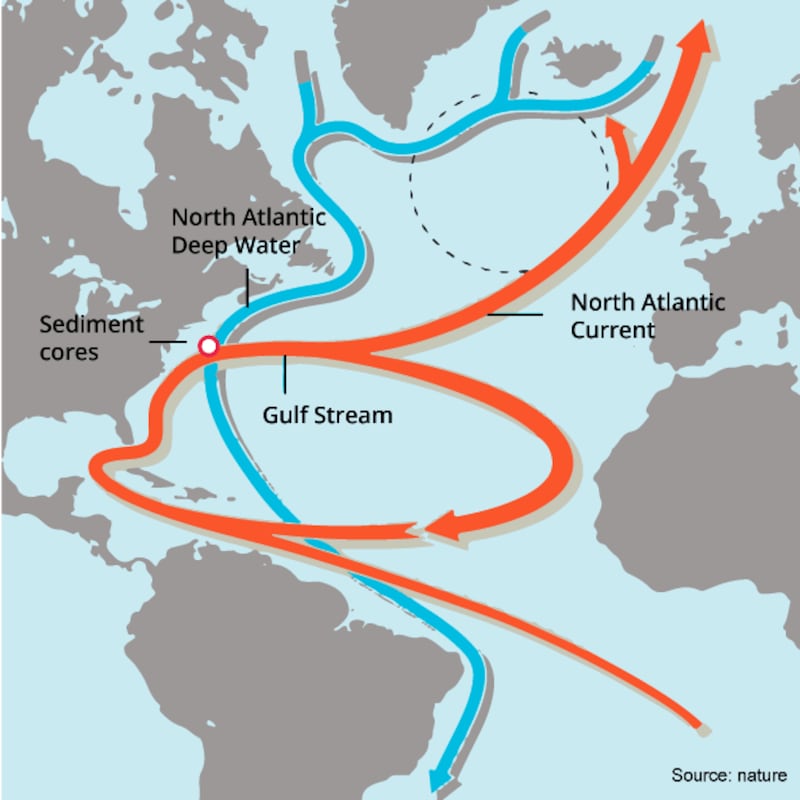The Gulf Stream in the north Atlantic ocean, which has a considerable effect on Ireland’s climate, is at its weakest in over a millennium. Human-caused global warming is the most likely cause, an international team of scientists has found.
A further slowdown of the Gulf Stream, also known as the Atlantic Meridional Overturning Circulation (Amoc), could imply more extreme weather events in Europe. This could manifest as winter storms coming off the Atlantic, possibly intensifying them.
Other studies found the possibility increases the potential for extreme heat waves or reductions in summer rainfall as a consequence. The immediate impact of this shift in increased rainfall and meltwater from ice sheets, and reduced salinity of the ocean, could cause significant sea rise on the east of the United States.

The researchers from Ireland, Britain and Germany have compiled data taken mainly from natural archives in the form of ocean sediment or ice cores – going back hundreds of years – to reconstruct the flow history of the Gulf Stream. They found consistent evidence its slowdown during the 20th century is unprecedented in the past millennium and is "likely linked to human-caused climate change". The giant ocean circulation has an impact on the climate of northwestern Europe.
"The Gulf Stream System works like a giant conveyor belt, carrying warm surface water from the equator up north and sending cold, low-salinity deep water back down south. It moves nearly 20 million cubic meters of water per second, almost a hundred times the Amazon flow," explained Prof Stefan Rahmstorf of Potsdam Institute for Climate Impact Research, initiator of the study published in Nature Geoscience.
“If we continue to drive global warming, the Gulf Stream System will weaken further – by 34 to 45 per cent by 2100, according to the latest generation of climate models,” said Prof Rahmstorf. “This could bring us dangerously close to the tipping point at which the flow becomes unstable.”
Previous studies showed a slowdown of the ocean current of about 15 per cent since the mid 20th century, “but a robust picture about its long-term development has up to now been missing. This is what the researchers provide with their review of results of proxy data studies,” he said.
"Instead of relying just on one data set, we used a combination of several different and largely independent proxy indicators to reconstruct the evolution of the Amoc over the past 1,600 years," said lead author Levke Caesar of Icarus climate research centre in Maynooth University.
The data indicate the Gulf Stream was relatively stable until the late 19th century. With the end of the little ice age in about 1850, the system of ocean currents began to decline, with a second, more drastic decline following since the mid-20th century.
Because long-term direct Gulf Stream measurements only started in 2004, the researchers applied an indirect approach to track its history. "Proxy data, as witnesses of the past, consist of information gathered from natural environmental archives such as tree rings, ice cores, ocean sediments, and corals, as well as from historical data for instance from ship logs," said Dr Caeser.
“We used a combination of three different types of data to obtain information about the ocean currents: temperature patterns in the Atlantic Ocean, subsurface water mass properties and deep-sea sediment grain sizes, dating back from 100 to circa 1,600 years. While the individual proxy data is imperfect . . . the combination of them revealed a robust picture of the overturning circulation,” she added.
She is part of the A4 project which is studying how Atlantic changes affect Ireland and northwestern Europe through changes in ocean circulation and sea level and developing capacity to predict likely effects.
How the Gulf Stream System works
A system slowdown has long been predicted by climate models as a response to global warming caused by greenhouse gases. A key process driving the Atlantic overturning is what scientists call “deep water formation”, triggered by the differences in the density of the ocean water: warm and salty water moves from the south to the north where it cools down and becomes more dense.
When it is heavy enough the water sinks to deeper ocean layers and flows back to the south. Under global warming "freshwater fluxes" arise from sea ice reduction, runoff from the melting Greenland ice sheet and increased precipitation as well as enhanced buoyancy from local surface warming are diluting the waters of the northern Atlantic by making the surface ocean warmer and fresher. This means it is less dense and it inhibits deep water formation and thus weakens system flow.
The weakening is linked to a unique substantial cooling of the subpolar North Atlantic over the past 100 years. This so-called “cold blob” was predicted by climate models as a result of a system weakening , which transports less heat into this region. Consequences of the slowdown could be manifold for people living on both sides of the Atlantic.
Dr Caesar added: "The northward surface flow of the Amoc leads to a deflection of water masses to the right, away from the US east coast. This is due to Earth's rotation that diverts moving objects such as currents to the right in the northern hemisphere and to the left in the southern hemisphere. As the current slows down, this effect weakens and more water can pile up at the US east coast, leading to an enhanced sea level rise."












